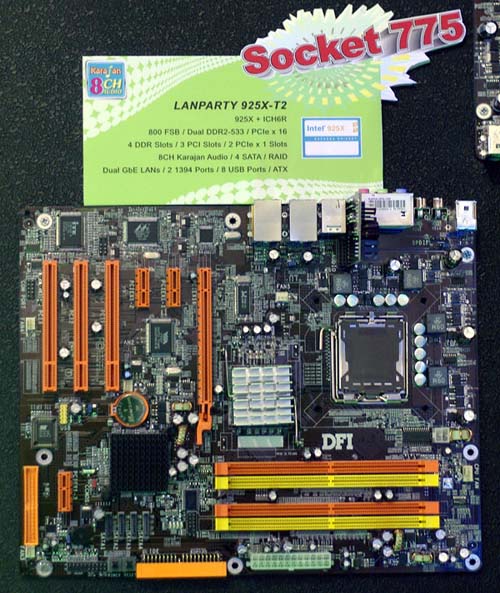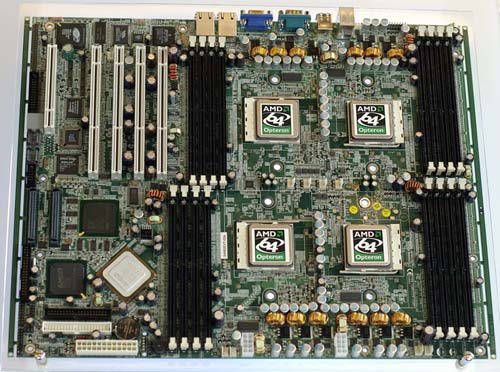Well, here's my first post about an upcoming Intel-based motherboard, but I couldn't help it. The DFI LANParty 925X-T2 enthusiast board has all the goodies, including PCI-Express, DDR2, and even 2 Gigabit ethernet ports...take a look.
It's going to be a couple of months before we see PCI-Express solutions with AMD systems, since the new chipsets are still under development. If only I could wait till the end of the summer to build my new PC, but each day I'm realizing more and more that a new computer is necessary for my survival :)
I must say that I may have to upgrade my PC next year to include these new technologies. We'll see how it all unfolds the second-half of 2004.
Technology analysis of the latest gadgets, consoles, and computer architectures.
Thursday, June 03, 2004
Well, it's been a long time since I've updated this post. I was out of town and touch with my computer for the week after exams, and then I got caught up into work and setting up my FreeBSD machine (more on that in another post).
In the meantime, I wasn't able to exchange my DI-514 router at Best Buy (I don't want to RMA!!) and AMD finally released the new Socket 939 chips (A64 3500+, 3800+, FX-53, etc.)! I spent a some time reading about them yesterday, but nothing much has changed; after all, the only differences between the 939 and the 754 chips are a double instead of a single channel memory controller and the 200 MHz HyperTransport upgrade, which brings the bus speeds to 1 GHz. In the Intel or Athlon XP world, this would be a big change, but with the integrated memory controller in A64 it accounts for a slight change, depending on the type of benchmark (see the FX-51 939 and 754 in action). Since the FX chips were previously limited to the 940 workstation and server socket architecture, the FX-53's move from buffered to unbuffered memory produced a larger difference.
In addition, the same chipsets are being used; the Nvidia nForce3-250 and the Via K8T800Pro. Both of these are second-generation chips, but the Nvidia chipset has a working PCI/AGP lock, which accounts for a much better overclocking experience.
Anyways, considering how soon I would like to be able to purchase and put together my computer, I won't be waiting around and paying premium prices for the 939 Athlon64s; besides, it doesn't seem like PCI Express will be supported until August or later.
Now, to unveal the candidate for Chief's Next Generation Computing Initiative (NGCI):
MSI K8N Neo Platinum Motherboard (read review)
- This mb features the latest and greatest Nvidia nForce3-250Gb chipset, supporting gigabit ethernet and an on-chip firewall.
- The motherboard's features include 8-channel audio, 4 usb 2.0 ports (with support for up to 8) and 1 firewire port, Serial-ATA and RAID support, and 3 DDR-400 slots for up to 2 GB of RAM.
- There are a plethora of overclocking options with this motherboard, as seen on the second page of the review.
- The only real limitation I've noticed is the support for only 2 GB of RAM (yes, only). There exist other Socket 754 Athlon64 motherboards that can support up to 3 GB, but usually with sacrifice to DDR speed. The only way I can jump into the realm of 4 GB of RAM would be to buy into the latest 939 socket motherboards (see above for why that won't be an option).
- Finally, this review of the latest nForce250 chipset motherboard demonstrates the power of the MSI motherboard. In the benchmarks, the MSI mb can be seen about average to near the top, and at the top for many near the end of the review.
Athlon 64 3200+
- 1 MB L2 Cache, 2.0 GHz with 800 MHz HyperTransport (i.e. bus)
- Isn't it amazing that a 2 GHz Athlon with the AMD64 architecture is rated a 3200+ while an Athlon XP with the same clock speed is rated a 2400+ :p
2 - 512 MB PC3200 DDR RAM
- I won't be getting HyperX or OCZ memory for my computer. In fact, I've already purchased some ValueRAM for a really good deal (around $80 per stick) from Kingston.com. The timings for these sticks are CL3 or 3-4-4, which is slow compared to the 2-2-3 I can get with a premium stick. However, looking at benchmark results found here for a similar 3200+ system with CL2, 2.5, and 3 timings, I decided that there would be no reason for me to spend the extra $140* total for the premium sticks, as the performance difference on an Athlon64 system is close to none.
- "We were duly impressed by the Athlon 64 FX-51's scores, which maintained its ranking no matter what kind of memory it was given. This steadfastness is largely due to the integrated memory controller." Tom's Hardware Guide
* This price was calculated using current Kingston prices for HyperX and ValueRAM.
This is where my computer plans get a little hazy.
ATI Radeon 9800 Pro 128?
- This is a very good graphics card, and it will largely depend on the cost whether I will opt for this one or go higher/lower. I may also choose a similar All in Wonder counterpart.
- It is not my intention to consider NVidia at the moment; although they are catching up with the latest generation of graphics cards, I do not plan on spending $400+ for one.
Nu-Tech DDW-082 8X DVD +/-RW
- I already have this drive, but I plan on moving it to my new PC so I might as well mention it. It achieved Anandtech's Editor's choice in the following review and I've only run into an incompatibility issue with my cheap DVD-R media, which I hope will be fixed in the next firmware update.
New hard drive?
- I may also choose to buy a 120/160 GB hard drive as I can find Western Digital and Maxtor drives at these sizes for around $100 with manufacturer warranty.
Some Kind of Case and Power Supply...
- I have begun looking, but still have a lot more surfing to do before I can make a decision.
Wow, you actually made it to the end of my post. I'm tired and you must be thorougly tired and bored by now as well, but if you would like to leave a comment in response to the newest AMD chips or my current PC plans please feel free. I'm out.
In the meantime, I wasn't able to exchange my DI-514 router at Best Buy (I don't want to RMA!!) and AMD finally released the new Socket 939 chips (A64 3500+, 3800+, FX-53, etc.)! I spent a some time reading about them yesterday, but nothing much has changed; after all, the only differences between the 939 and the 754 chips are a double instead of a single channel memory controller and the 200 MHz HyperTransport upgrade, which brings the bus speeds to 1 GHz. In the Intel or Athlon XP world, this would be a big change, but with the integrated memory controller in A64 it accounts for a slight change, depending on the type of benchmark (see the FX-51 939 and 754 in action). Since the FX chips were previously limited to the 940 workstation and server socket architecture, the FX-53's move from buffered to unbuffered memory produced a larger difference.
In addition, the same chipsets are being used; the Nvidia nForce3-250 and the Via K8T800Pro. Both of these are second-generation chips, but the Nvidia chipset has a working PCI/AGP lock, which accounts for a much better overclocking experience.
Anyways, considering how soon I would like to be able to purchase and put together my computer, I won't be waiting around and paying premium prices for the 939 Athlon64s; besides, it doesn't seem like PCI Express will be supported until August or later.
Now, to unveal the candidate for Chief's Next Generation Computing Initiative (NGCI):
MSI K8N Neo Platinum Motherboard (read review)
- This mb features the latest and greatest Nvidia nForce3-250Gb chipset, supporting gigabit ethernet and an on-chip firewall.
- The motherboard's features include 8-channel audio, 4 usb 2.0 ports (with support for up to 8) and 1 firewire port, Serial-ATA and RAID support, and 3 DDR-400 slots for up to 2 GB of RAM.
- There are a plethora of overclocking options with this motherboard, as seen on the second page of the review.
- The only real limitation I've noticed is the support for only 2 GB of RAM (yes, only). There exist other Socket 754 Athlon64 motherboards that can support up to 3 GB, but usually with sacrifice to DDR speed. The only way I can jump into the realm of 4 GB of RAM would be to buy into the latest 939 socket motherboards (see above for why that won't be an option).
- Finally, this review of the latest nForce250 chipset motherboard demonstrates the power of the MSI motherboard. In the benchmarks, the MSI mb can be seen about average to near the top, and at the top for many near the end of the review.
Athlon 64 3200+
- 1 MB L2 Cache, 2.0 GHz with 800 MHz HyperTransport (i.e. bus)
- Isn't it amazing that a 2 GHz Athlon with the AMD64 architecture is rated a 3200+ while an Athlon XP with the same clock speed is rated a 2400+ :p
2 - 512 MB PC3200 DDR RAM
- I won't be getting HyperX or OCZ memory for my computer. In fact, I've already purchased some ValueRAM for a really good deal (around $80 per stick) from Kingston.com. The timings for these sticks are CL3 or 3-4-4, which is slow compared to the 2-2-3 I can get with a premium stick. However, looking at benchmark results found here for a similar 3200+ system with CL2, 2.5, and 3 timings, I decided that there would be no reason for me to spend the extra $140* total for the premium sticks, as the performance difference on an Athlon64 system is close to none.
- "We were duly impressed by the Athlon 64 FX-51's scores, which maintained its ranking no matter what kind of memory it was given. This steadfastness is largely due to the integrated memory controller." Tom's Hardware Guide
* This price was calculated using current Kingston prices for HyperX and ValueRAM.
This is where my computer plans get a little hazy.
ATI Radeon 9800 Pro 128?
- This is a very good graphics card, and it will largely depend on the cost whether I will opt for this one or go higher/lower. I may also choose a similar All in Wonder counterpart.
- It is not my intention to consider NVidia at the moment; although they are catching up with the latest generation of graphics cards, I do not plan on spending $400+ for one.
Nu-Tech DDW-082 8X DVD +/-RW
- I already have this drive, but I plan on moving it to my new PC so I might as well mention it. It achieved Anandtech's Editor's choice in the following review and I've only run into an incompatibility issue with my cheap DVD-R media, which I hope will be fixed in the next firmware update.
New hard drive?
- I may also choose to buy a 120/160 GB hard drive as I can find Western Digital and Maxtor drives at these sizes for around $100 with manufacturer warranty.
Some Kind of Case and Power Supply...
- I have begun looking, but still have a lot more surfing to do before I can make a decision.
Wow, you actually made it to the end of my post. I'm tired and you must be thorougly tired and bored by now as well, but if you would like to leave a comment in response to the newest AMD chips or my current PC plans please feel free. I'm out.
Subscribe to:
Comments (Atom)

